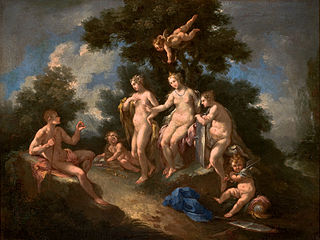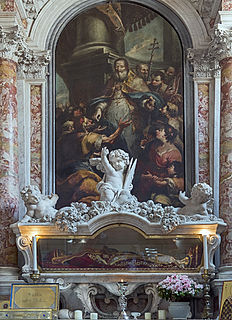
Michele Mercati was a physician who was superintendent of the Vatican Botanical Garden under Popes Pius V, Gregory XIII, Sixtus V, and Clement VIII. He was one of the first scholars to recognise prehistoric stone tools as human-made rather than natural or mythologically created thunderstones.

Francesco Brizio (1574–1623) was an Italian painter and engraver of the Bolognese School, active in the early-Baroque.

Ottavio Vannini was an Italian artist of the Baroque period, active mainly in Florence.

Michele di Matteo, also sometimes used with further qualifications of da Bologna or Lambertini was an Italian painter of the late Gothic period in Bologna.

Michele Rocca was an Italian painter of the Baroque period. He was born in Parma and practised in Rome, and died some time after 1751. He was also called Parmigianino the younger or Michele da Parma. He worked in the manner of Pietro da Cortona.
Michele Ridolfi was an Italian painter and art critic.

Antonio Barbalonga or Barbalunga, also called Antonio Alberti, was an Italian painter of the Baroque period.

Michele Alberti was an Italian painter of the latter half of the 16th century.

Michele Bisi was an Italian engraver and painter born in Genoa. His work is identified with the schools of Bartolozzi, Rosaspina, and Longhi.

Michele da Verona was an Italian painter of the Renaissance period. He is different but a near contemporary of Zenone Veronese.
Giovanni Battista della Marca (1532–1587) was an Italian painter of the Renaissance period.

Jacopo Marieschi (1711–1794) was an Venetian history painter. Formerly he was confused with the prominent vedute painter, Michele Marieschi, his close contemporary.
Antonio Dardani (1677–1735) was an Italian painter of the Baroque period, mainly in his native Bologna..

Michael Bryan was an English art historian, art dealer and connoisseur. He was involved in the purchase and resale of the great French Orleans Collection of art, selling it on to a British syndicate, and owned a fashionable art gallery in Savile Row, London. His book, Biographical and Critical Dictionary of Painters and Engravers, first published in 1813–1816, was a standard reference work throughout the 19th century, and was last republished in 1920; however it is now badly outdated.
Nicolaus van Aelst was a Flemish engraver and perhaps painter, resident in Rome.

Michele Pace del Campidoglio (1625-1669) was an Italian painter of still-life depicting fruit and flowers.

Andrea di Aloigi, called L'Ingegno, was an Italian Renaissance painter.

Michele Coltellini (1480–1542) was an Italian painter, active mainly in Ferrara.

Giovanni di Bartolomeo Cristiani was an Italian painter active in Pistoia and Pisa in the second half of the 14th century.

Georg Christoph Eimmart the Younger, a German draughtsman and engraver, was born at Ratisbon. He was instructed by his father, Georg Christoph Eimart the Elder (1603-1658), who was also an engraver, a painter of portraits, landscapes, still-life, and historical subjects. He studied at the University of Jena from 1654-1658. Eimmart the Younger resided at Nuremberg, where he died in 1705. He engraved some plates for Sandrart's Academia, and some small etchings of ruins, buildings, and vases, ornamented with figures, which have considerable merit. He was also a mathematician and astronomer, and published in 1701 Iconographia nova contemplationum de Sole.



















